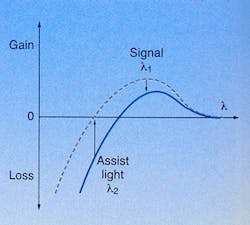Researchers in Taiwan have begun study on a new type of all-optical interconnection system that could eventually be applied to computing and networking. It allows information to be relayed to a central node on the network, allowing other nodes to request the information optically, or not, as required. Though the current continuous-wave demonstrator is extremely slow—requests can take up to ten seconds to be answered—researchers say that much faster implementations are possible. The photorefractive effect exploited in their system has also been shown to work with pico- and femtosecond pulses.
The core of the optical-request setup developed at Mingshin Institute of Technology, Hsin-Chu, is the photorefractive crystal barium titanate (BaTiO3).1 In operation an image is relayed from a signal feeding port to the central unit via an argon-ion laser beam (see figure). Because this light comes in perpendicular to the 0°-cut crystal, it passes through essentially undeviated in the absence of any other beam of light. Nevertheless, this is all that is required in order to provide the central unit with the information held by the feeder port.
To retrieve that information, a signal requesting port sends in a second beam of light (coherent with the first), this time at 10°. If the image beam were not there, this beam would form a phase conjugate mirror. This is a phenomenon that occurs when the refractive index of a material changes thanks to the incoming light, and this in turn changes the path of the light, which in turn changes the refractive index. Essentially, the nonlinear medium is allowing light to interfere with itself. The result is the creation of a time-reversed copy of the beam: the light goes back on itself.
When both beams are present, two things happen. The phase-conjugate mirror is still produced, but a second phenomenon also takes place. Though only three beams are present (signal, request, and phase-conjugate of request) these are enough to allow a process known as four-wave mixing. Essentially, this causes energy from one beam to be picked up by the other—a kind of optical amplification. Because the intensity of the signal beam (from which energy is diverted) is modulated, the request beam picks up this modulation too. Crucially, the signal and request beams intersect before the plane of the phase-conjugate mirror; thus, the light that travels back to the requesting port also carries the information.
The Mingshin group has been concentrating on optimizing the quality of the image received at the request port. With equal-intensity request and signal beams, the image is overlaid by a flat light field (like a dc bias) that comes from the original request beam. By keeping the request-beam intensity low (or by periodically blocking it), this can be reduced or even eliminated. Another feature of the system is that the image to be transferred can be inverted by using ordinary polarization of the signal beam rather than extraordinary.
Another issue the researchers have looked at is the sequence of events and how that affects the timing. Faster transfer (1-s delay) is possible if the request beam is already waiting by the time the signal arrives. If the signal gets there first, however, the process can take as long as ten seconds (the difference is due to the time taken to build up the phase-conjugate mirror). This extra delay can be avoided by creating the mirror (with the request beam) and then reducing the intensity of the light to a lower level until it needs to be activated.
Though the 1-s delay is still orders of magnitude higher than could be useable in a real system, researchers suggest that the concept could be extended to other, much faster, nonlinear materials and light sources.
REFERENCE
- Hsiao Yi Lee et al., Appl. Opt. 39, 6656 (December 10, 2000).
